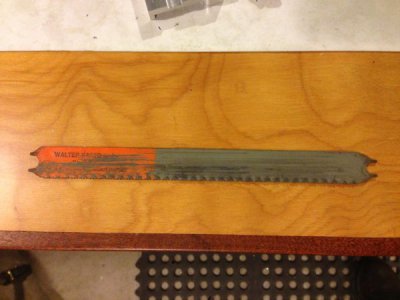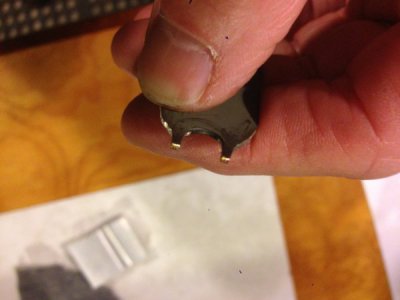-
Welcome back Guest! Did you know you can mentor other members here at H-M? If not, please check out our Relaunch of Hobby Machinist Mentoring Program!
You are using an out of date browser. It may not display this or other websites correctly.
You should upgrade or use an alternative browser.
You should upgrade or use an alternative browser.
New Lathe User - Just Bought An Atlas MK2 6x18
- Thread starter Skowinski
- Start date
- Joined
- Dec 25, 2011
- Messages
- 10,508
First, the special nuts are nuts, not screws. Second, yes, they are OEM. And are far from being unique to the Atlas machines. They aren't perhaps as common on new equipment today as they once were. But if you work on older equipment including both machine tools and military grade electronics, you will run into them in various sizes.
Buying a new tool today that fits is unlikely. But making one is simple. Measure the OD of the nut. Unless you already have one that you just haven't thrown away, buy the cheapest set of 6-point long-pattern 1/4" square-drive sockets that you can find. Measure the OD's for one that is about the same OD as the nut. Mill (or accurately grind and file) both sides of the open end, leaving two tangs sticking out. The tangs need to be fairly close to being on a diameter of the socket, and centered in two opposite thickest parts of the socket. The ID should be a slip fit over the screw that the nut fits. And the tangs need to fit the slots in the nut. I've made about half a dozen of them over the years, in different sizes up to about 3/4" diameter.
You can also make a tool from a screwdriver that fits the slot in the nut when it is off of the machine by running an end mill the same diameter as the screw across the end of the screw driver blade. But the tool made from the socket is less likely to slip and damage the nut.
Buying a new tool today that fits is unlikely. But making one is simple. Measure the OD of the nut. Unless you already have one that you just haven't thrown away, buy the cheapest set of 6-point long-pattern 1/4" square-drive sockets that you can find. Measure the OD's for one that is about the same OD as the nut. Mill (or accurately grind and file) both sides of the open end, leaving two tangs sticking out. The tangs need to be fairly close to being on a diameter of the socket, and centered in two opposite thickest parts of the socket. The ID should be a slip fit over the screw that the nut fits. And the tangs need to fit the slots in the nut. I've made about half a dozen of them over the years, in different sizes up to about 3/4" diameter.
You can also make a tool from a screwdriver that fits the slot in the nut when it is off of the machine by running an end mill the same diameter as the screw across the end of the screw driver blade. But the tool made from the socket is less likely to slip and damage the nut.
- Joined
- Nov 18, 2012
- Messages
- 1,352
On my 618 I took a piece of flat metal of the width to fit the OD of the nut and filed a notch in the centre to clear the screw. You could also sacrifice an old cheap screwdriver and cut the notch in the blade.
David
David
- Joined
- Dec 25, 2011
- Messages
- 10,508
Well, the notched screwdriver is certainly quicker than a copy of the OEM tool. But one of the problems with it is that it only works if the screw never protrudes out of the nut. The ones made from a 6-point socket don't have that problem.
- Joined
- Nov 9, 2017
- Messages
- 222
I probably should dig around some more in these drawers in the cabinet this lathe came mounted on. Could be a tool buried in there somewhere. There's stuff I still haven't figured out what it is. Some odd custom jigs etc, and parts I don't recognize (not surprising since I'm such a noob...).
- Joined
- Nov 9, 2017
- Messages
- 222
So, it appears I've got most of what's needed to use collets with this lathe. But, I'm missing the spindle thread protector and a spacer that goes on the drawbar. It's too long without that and won't tighten a collet in the spindle. I think I'll make one and was wondering if anyone's got one of these that they could provide me with the dimensions of?
Looks like MyMachineShop.net sells complete sets and they appear to call this thing a "gear door spacer".
https://www.mymachineshop.net/ProductDetails.asp?ProductCode=10001
Looks like MyMachineShop.net sells complete sets and they appear to call this thing a "gear door spacer".
https://www.mymachineshop.net/ProductDetails.asp?ProductCode=10001
- Joined
- Feb 14, 2016
- Messages
- 623
What parts do you have so far Skowinski ? I'm starting to collect parts for mine too , so far I have a collet set (mt2) got it here https://www.ebay.com/itm/2-Morse-Ta...440089?hash=item1e9944c619:g:gMoAAOSw~RVaME0m I got this little hand wheel https://www.ebay.com/itm/1Pc-3-Electroplating-Handwheel-OD-69mm-Machinist-Cast-Iron-Tailstock-Hand-Wheel/152385218779?ssPageName=STRK:MEBIDX:IT&_trksid=p2055119.m1438.l2649 so all I have to do now is make the spacer and get some threaded stock . Only bummer with using a mt 2 collet in the spindle is the collet sticks out about .5 past the spindle . I don't think it's a deal killer we are not taking heavy cuts but collets are machinable so you could trim some back if it's a problem . The thing they are calling a gear door spacer is the spacer that goes at the opposite of the collet , you can make that easy . Plus you don't really need a hand wheel , just get a long enough bolt make the spacer and use a wrench to do the tighten up . I have seen real Atlas collet set ups that use the nose piece I think that set up is the best . It's here they call it the draw in collet chuck attachment http://www.lathes.co.uk/atlas-6-inch-lathe-accessories/ this set up is a true collet set up where you also still have a thru spindle capability .
- Joined
- Nov 9, 2017
- Messages
- 222
Thanks, what I have appears to be the "holding collet set" shown on the 6" lathe accessories page you linked, minus the collar/spacer. There's also a set shown on the printed accessories catalog that came with this lathe, and it shows that same handwheel with the spacer and a "milling cutter holder" which is the MT2 collar with a set screw, which I have, but no spacer. I've made some measurements and will fabricate a spacer, should be an easy enough project. Should be able to use this collet set I have then.
- Joined
- Dec 25, 2011
- Messages
- 10,508
With either a draw bar (for 2MT collets and the Atlas M6-945 Cutter Holder) or a draw tube (for the Atlas M6-751 collets), you want to use about half of the available threads at the tightened point. To determine the required length of the spacer, first determine the number of threads available on or in the collets. With the M6-751, the threads are on the outside of the collet so you just count them. With the other two, slide the collet or holder into the spindle until the taper stops it. Slide the drawbar into the left end of the spindle up against the threads in the end of the collet. Rotate the handwheel CCW and locate the thread start. Then start turning it CW, counting the number of turns until the drawbar bottoms out on the last thread. Multiply the number of threads by about 0.45 and round up. Screw the tube or bar onto or into the collet the calculated number of turns. Pull back lightly on the handwheel and measure the distance between the left end of the spindle and the right end of the handwheel hub. This is the effective length that you need for the spacer.
All of the commercial spacers thst I have seen sold have the right end tapered at about 60 deg. This works (because the left end of the spindle is slightly countersunk and it's quicker and cheaper to machine. But it isn't very convenient to use as it won't stay centered up with the spindle bore on its own until it is almost tight. So make the spacer about 3/16" longer than calculated and turn the right end down to about 17/32" for a distance of 3/16". This will stay centered making it easier to start the draw bar or tube threads onto or into the collet or holder without danger of cross-threading.
All of the commercial spacers thst I have seen sold have the right end tapered at about 60 deg. This works (because the left end of the spindle is slightly countersunk and it's quicker and cheaper to machine. But it isn't very convenient to use as it won't stay centered up with the spindle bore on its own until it is almost tight. So make the spacer about 3/16" longer than calculated and turn the right end down to about 17/32" for a distance of 3/16". This will stay centered making it easier to start the draw bar or tube threads onto or into the collet or holder without danger of cross-threading.




